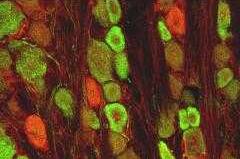Human/Rat GDNF Antibody
R&D Systems, part of Bio-Techne | Catalog # AF-212-NA


Key Product Details
Species Reactivity
Validated:
Cited:
Applications
Validated:
Cited:
Label
Antibody Source
Product Specifications
Immunogen
Arg109-Ile211
Accession # P39905
Specificity
Clonality
Host
Isotype
Endotoxin Level
Scientific Data Images for Human/Rat GDNF Antibody
GDNF and GFR alpha‑1 in Rat Dorsal Root Ganglia.
GDNF and GFRa-1 were detected in perfusion fixed frozen sections of rat dorsal root ganglia using 10 µg/mL Goat Anti-Human/Rat GDNF Antigen Affinity-purified Polyclonal Antibody (green; Catalog # AF-212-NA) and 15 µg/mL Biotinylated Goat Anti-Rat GFRa-1 Antigen Affinity-purified Polyclonal Antibody (red; Catalog # BAF560). Tissue was incubated with primary antibodies overnight at 4 °C. View our protocol for Fluorescent IHC Staining of Frozen Tissue Sections.Proliferation Induced by GDNF and Neutralization by Goat GDNF Antibody.
Recombinant Human GDNF (Catalog # 212-GD) induces proliferation in the SH-SY5Y human neuroblastoma cell line in the presence of Recombinant Human GFRa-1/GDNF Ra-1 Fc Chimera (Catalog # 714-GR) in a dose-dependent manner (orange line), as measured by Rezazurin (Catalog # AR002). Under these conditions, proliferation elicited by GDNF is neutralized (green line) by increasing concentrations of Goat Anti-Human/Rat GDNF Antigen Affinity-purified Polyclonal Antibody (Catalog # AF-212-NA). The ND50 is typically 0.25-1 µg/mL.Applications for Human/Rat GDNF Antibody
Immunohistochemistry
Sample: Perfusion fixed frozen sections of rat dorsal root ganglia
Western Blot
Sample: Recombinant Human GDNF (Catalog # 212-GD)
Neutralization
Reviewed Applications
Read 5 reviews rated 4.6 using AF-212-NA in the following applications:
Formulation, Preparation, and Storage
Purification
Reconstitution
Formulation
Shipping
Stability & Storage
- 12 months from date of receipt, -20 to -70 °C as supplied.
- 1 month, 2 to 8 °C under sterile conditions after reconstitution.
- 6 months, -20 to -70 °C under sterile conditions after reconstitution.
Background: GDNF
Glial Cell Line-derived Neurotrophic Factor (GDNF) is a neurotrophic factor that has been shown to promote the survival of various neuronal subpopulations in both the central as well as the peripheral nervous systems at different stages of their development. Neuronal subpopulations that have been shown to be affected by GDNF include motoneurons, midbrain dopaminergic neurons, Purkinje cells and sympathetic neurons.
Native GDNF, a disulfide-linked homodimeric glycoprotein, is a novel member of the TGF-beta superfamily. Human GDNF cDNA encodes a 211 amino acid residue prepropeptide that is processed to yield a dimeric protein. Mature human GDNF was predicted to contain two 134 amino acid residue subunits. NS0 expressed mature human GDNF lacks 31 residues from the amino-terminus of the predicted sequence. This glycosylated recombinant mature human GDNF still contains the seven conserved Cys residues found in all members of the TGF-beta superfamily and is biologically active. The GDNF sequence contains two potential glycosylation sites and insect cell-expressed recombinant rat GDNF proteins are glycosylated. Mature rat and human GDNF exhibit approximately 93% amino acid sequence identity and show considerable species cross-reactivity. Cells known to express GDNF include Sertoli cells, type 1 astrocytes, Schwann cells, neurons, pinealocytes and skeletal muscle cells.
Long Name
Alternate Names
Gene Symbol
UniProt
Additional GDNF Products
Product Documents for Human/Rat GDNF Antibody
Product Specific Notices for Human/Rat GDNF Antibody
For research use only
